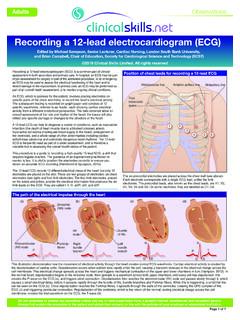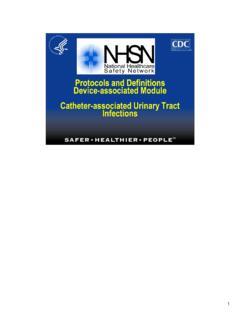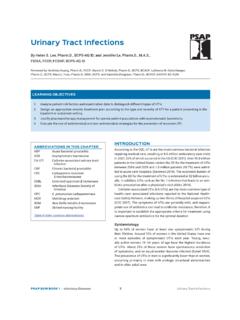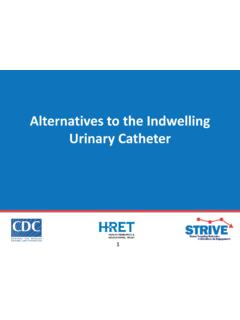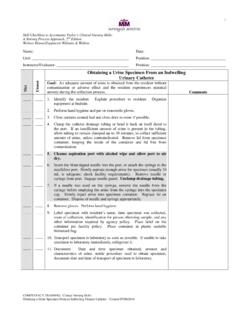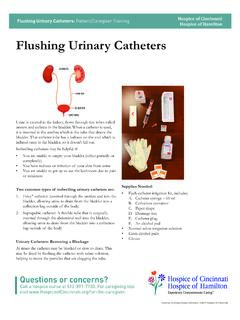Transcription of CATHETER CARE P1 - Clinical Skills
1 Guidance from the National Institute for Health and Care Excellence (NICE, 2017) suggests that indwelling urinary catheters should only be used after alternative methods of managing urinary problems have been considered. Some patients may feel apprehensive about having a CATHETER inserted. The procedure may have been necessary to relieve urinary retention, or to improve the patient s quality of life and offer greater independence. It is essential that patients who have had an indwelling CATHETER inserted are given adequate information on how to care for their CATHETER and change the drainage equipment. If patients are too ill to care for their own CATHETER , or lack the mobility or manual dexterity to do so, healthcare professionals and/or their carers will need to take responsibility for this aspect of care.
2 Some patients may be able to choose between using a continuous urine drainage bag or a CATHETER information on how to remove a CATHETER , see the procedure, Trial removal of a CATHETER .Page 1 of 5 CatheterisationAdultsCatheter careEdited by Rachel Leaver, Lecturer Practitioner Urological Nursing, University College London Hospital NHS Foundation Trust 2019 Clinical Skills Limited. All rights reservedSelection of equipment leg bagSelection of equipment CATHETER valveIf a leg bag is the most appropriate urinary drainage system for the patient, the following features will influence your choice: the length of the drainage tubing (short, medium or long), the volume of urine to be contained (350 mL, 500 mL, 750 mL) and the outlet tap, which needs to be easy to open for the user/carer.
3 Most leg bags have an integral sampling port to enable a urine sample to be who have bladder sensation, a stable bladder, and who are likely to have a trial without CATHETER , should be offered a CATHETER valve rather than a continuous drainage bag. The patient can release the CATHETER valve several times a day when they feel that the bladder is full and needs to be emptied. It is therefore necessary to carefully assess the patient and their bladder function before selecting a CATHETER valve. Several types of CATHETER valves are available. A continuous drainage bag can be attached to most CATHETER valves to allow urine drainage overnight. In an acute setting, a valve-less CATHETER on continuous drainage into a large-capacity bag is most commonly used. CATHETER valves that are currently available on the Drug Tariff should be changed every 5 7 days, in accordance with local policy and the manufacturer s recommendations.
4 A CATHETER valve is contraindicated for patients with reduced bladder capacity, absence of bladder sensation and cognitive impairment, as well as those who do not have the manual dexterity to operate the CATHETER not undertake or attempt any procedure unless you are, or have supervision from, a properly trained, experienced and competent first explain the procedure to the patient and obtain their consent, in line with the policies of your employer or educational approx 500 400 300 200 100 Before use, read manufacturer s instructionsOutlet tapContinuousdrainage (leg) bagInlet tubeSafety-lock tap openSafety-lock tap closedLever tap openLever tap closedPush/pull tap openPush/pull tap closedTextured surfaceCatheterisation AdultsCatheter care Page 2 Outlet tapsPatients need good manual dexterity in order to open the outlet tap and so empty the bag.
5 The illustration shows some of the outlet taps that are currently available. These include lever taps and push/pull devices. The safety-lock tap must be pushed down and then squeezed to start the flow of urine. Patients with poor vision can feel for the textured surface on some of these devices, to guide them when opening the 2 of 5 Do not undertake or attempt any procedure unless you are, or have supervision from, a properly trained, experienced and competent first explain the procedure to the patient and obtain their consent, in line with the policies of your employer or educational MLAPPROX ML100500100015002000 Recommendedweartime 5-7 daysDate bag fitted:750500300100 Approx. ml750ml SHORT TUBEmLapprox 500 400 300 200 Large-capacity bags used overnight or postoperativelyLeg bagsmL approx 750 500 250 100 500350250100 Approx.
6 Ml500ml SHORT TUBE 500 400 300 200 100 Approx drainage bag capacityThe leg bags worn by most patients hold 350 mL, 500 mL or 750 mL, although larger sizes can also be obtained. Specially designed larger-capacity leg bags are available for wheelchair users. If the patient prefers to use a large-capacity bag overnight, 2-litre continuous drainage bags (not worn on the body) are available; either single-use bags which usually have no drainage tap into which the leg bag can drain, or reusable bags with taps which can be attached to the leg bag or directly to the CATHETER itself to allow urine to drain. These drainage bags should be worn below the level of the bladder to allow efficient urine drainage. There are also bags which can be worn on the abdomen, roughly level with the bladder, which have an anti-reflux valve to prevent urine flowing back into the approx 750 500 250 100 approx 500 400 300 200 mlml approx 750 500 250 100 100100500500100010001500150020002000 APPROX MLAPPROX MLShort tubeLong tubeDirect inletLength of the inlet tubeSupporting accessoriesWhether the drainage bag will be held on the thigh, knee or calf will determine the inlet tube length of the bag selected.
7 The tube may be short, long or adjustable in length, or the bag may have a direct inlet. Ask the patient where they prefer to wear the drainage bag. There are several ways of fixing the drainage bag to the leg, which help to support the bag and prevent traction on the CATHETER . These include open-weave net sleeves to fit the thigh or calf, leg straps and garments; some are available on prescription. All leg bags must be changed every 5 7 days, or as recommended by the AdultsCatheter care Page 3 Emptying the drainage bag: (a) Preparation(b) Open the valve(c) Clean the outlet port(d) Dispose of urineIn preparation for emptying the drainage bag, put on an apron, wash your hands and put on clean, non-sterile gloves. Ask the patient to sit in a suitable position. Hold the valve over a disposable container or jug, and open the valve.
8 Empty the drainage bag, ensuring that the tap does not touch the container. Use a separate and clean container for each patient (Loveday et al., 2014).When all the urine has drained out, close the valve. Clean the outlet port, and allow it to dry, according to local policy. See also procedure on Emptying an indwelling urinary CATHETER bag .In order to preserve the patient s dignity it is important to cover the jug in which the discarded urine is transported to the toilet or sluice. After disposing of urine, remove gloves and apron and wash hands. If the patient is able to, and if the urine does not need to be measured, encourage them to empty the drainage bag directly into the toilet. Ensure that patients have access to handwashing facilities if they undertake this procedure (Loveday et al.)
9 , 2014).Page 3 of 5Do not undertake or attempt any procedure unless you are, or have supervision from, a properly trained, experienced and competent first explain the procedure to the patient and obtain their consent, in line with the policies of your employer or educational AdultsCatheter care Page 4 Cleaning the CATHETER and surrounding area: (a)(b) Clean away from the urethral opening(c) Females: clean from front to backDrainable 2-litre bagUrine bag standWhen cleaning the urethral orifice, it is important to clean away from the opening, to avoid contaminating the CATHETER where it enters the body. If undertaking CATHETER care for the patient, the healthcare professional or carer should clean around the CATHETER site where it enters the urethra at least once a day, using mild soap and water with a single-use cloth (NICE, 2019).
10 In females, take care to clean from front to back, , wipe away from the urethral orifice towards the perineum/anus. After cleaning, remove gloves, then apron and wash your hands (Loveday et al., 2014). Report and record in the notes any signs of discharge that may be cause for concern. Daily washing is recommended, but if discharge is thick and copious it may be necessary to wash more 2-litre bags are available for postoperative use or for patients who are confined to bed. These bags may also be used for monitoring urine output, particularly in the presence of haematuria. The drainable bag is sterile and therefore designed to be attached directly to the bags should be changed every 5 7 days, in accordance with local policy and manufacturer s recommendations. It is important to secure a 2-litre urinary bag to an appropriate stand, so that the outlet tap is not touching the floor, thus preventing contamination of the outlet tap (Loveday et al.)



